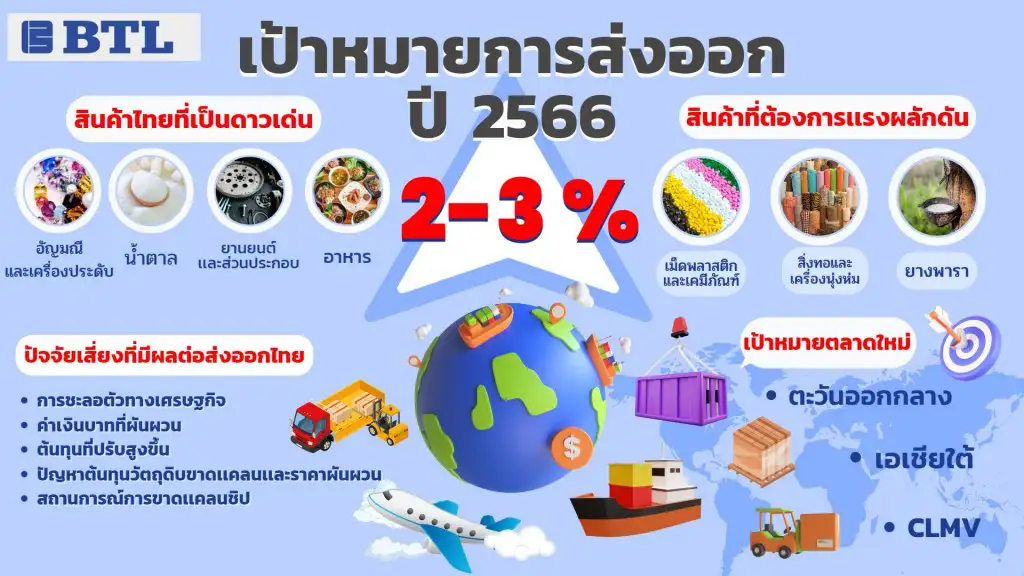



It is expected that the overall trend of Thai export target in 2023 will expand by 2-3% based on the assessment of export in 2022.
Thai exports have begun to show a clear slowdown after the export target value in October and November 2022 was negative for 2 consecutive months, which has caused concern for many parties. The clear tendency for exports in 2023 to slow down has resulted in the need to find a response plan to support exports, which are the main variable in the recovery of the Thai economy.
Mr. Chaichan Charoensuk, President of the Thai National Shippers’ Council, revealed that the Thai National Shippers’ Council (TNSC) predicts that the overall trend of Thai export targets in 2023 will expand by 2-3%.
Based on the assessment of exports in 2022, exports in terms of volume did not increase significantly. Looking at the number of shipping containers in 2022, it is close to 2021. However, the prices of raw materials and oil have increased, and the impact of the baht depreciating more than the currencies of competitors in the foreign market.
In 2023, oil prices are estimated to be lower than 2022, at $75-85 per barrel, and the baht will be at 33-35 baht per dollar, possibly stronger than competitors’ currencies. Therefore, in 2023, prices will be pressured, which tends to decrease in line with oil and raw material prices.
Therefore, food products still have potential as a result of the food shortage because the war zone in Ukraine is still unable to cultivate and there is no prospect of peace negotiations.
For other industrial products, it varies according to each country’s economic situation, such as the automotive industry, where the chip shortage problem has begun to ease, which has had a positive effect on the production of automotive parts, electrical appliances, and electronic parts.
Factors affecting world trade in 2023 include:
However, the National Economic and Social Development Board (NESDB) sees that in 2023, export products will have both opportunities and products that require more effort.
Products with opportunities in 2023 include:
Products that require more effort in 2023 include:
Meanwhile, the product group still has an opportunity to expand exports, but it needs to put in effort and focus on secondary potential markets that are starting to expand and recover from COVID, such as the Middle East.
What needs to be done urgently is to penetrate new markets and maintain existing markets. We need to quickly open up markets in emerging countries.
All of South Asia, the Middle East, ASEAN, CLMV, especially the Middle East, such as Saudi Arabia, after the restoration of trade relations between each other
In addition, it is necessary to create product awareness, build deeper trade relations with new trading partners, customize products to be more relevant to destination countries, and push exports.
In summary, Thailand’s export target must be adjusted to ” 2 increases, 2 decreases “, which are adding new market channels , increasing financial liquidity, reducing product costs , and reducing inventory to prevent various risks and prepare for adjustment in the challenging year 2023,” said Mr. Chaichan Charoensuk.
Mr. Jurin Laksanawisit, Deputy Prime Minister and Minister of Commerce, said that the 2023 export plan aims to penetrate markets with potential and increase export volume from the normal measures that have been set in advance on a case-by-case basis, penetrating 3 large markets with potential, including:
The 3 major markets in 2022 are expected to have a combined export value of 1.7 trillion baht and in 2023 will increase to 2 trillion baht, consisting of:
1. Middle Eastern market, focusing on 3 major markets:
The main target products are food, automotive parts, air conditioners, and construction materials, etc.
The goal in 2023 is to increase export figures from these three countries by 20% from 8.9 billion dollars in 2022.
It is $10.3 billion in 2023.
2. South Asian market focuses on 3 important countries:
The export target in 2023 in these 3 countries, the South Asian market, increased by 10%, increased from 2022 at 12 billion dollars, increased to 13.2 billion dollars in 2023, with a focus on important products such as chemicals, plastic pellets, automotives.
and automotive parts, etc.
3. CLMV market consists of
Target to increase exports by 10-15% from $28 billion in 2022 to $33.5 billion in 2023.
Key targets include construction materials, electrical appliances, plastic pellets, textiles, and clothing.
Source of information: Bangkok Business
————————–
Contact BTL service inquiries at 02-681-2005 to 9.